 The first aircraft my old man ever flew in was a B-17E Flying Fortress. Quite a claim but supported by his first logbook entry. On 17th April 1943 with nothing to do during an ATC camp at Bovingdon Airfield he and his mate wandered across to a parked Flying Fortress and asked the groundcrew if they could have a ride in an aeroplane please. As it happened the mechanics were about to carry out a check flight on it and asked the pilot if they could (rather unofficially) go along. “Sure boys, jump aboard,” he said and before they knew it they were in the cockpit watching everything that was going on. He noted the procedure, Landing gear switches ‘OFF’. Battery switches OFF, mixture to ENGINE OFF and the throttles set to 800rpm. “Clear Props,”. Emergency switches to ON. Spare inverter switch ON. Turn on fuel booster pumps and wait for at least 8psi then “Start engines” was called. The start up order he noted was 3 (starboard inner), 4 (starboard outer), 2 (port inner), 1 (port outer). The Co-pilot flicked number 3 starter switch and after one turn the Magnetos were set to ‘BOTH’ and whilst pumping the hand-primer the engine was swung over until on the sixth revolution, with a crackle and plume of smoke, it fired. The mixture was then set to ‘AUTO RICH’ and hand-priming was continued until she settled. Opening the throttle at start up, he was told, usually resulted in a backfire followed by an engine fire hence the ground crew strategically placed with fire extinguishers! He recalled how incredibly noisy it was and that they ran the engines for a fair while before moving off, checking pressures and the like. So long that he was concerned their illicit flight would be discovered and they’d be ordered off. Finally it was ‘Chocks away’ and they taxied out onto the main east west runway and at 15.15 took off and headed out across the Chilterns towards Cheddington. The flight lasted 40 minutes but it was really something else and he never forgot it.
The first aircraft my old man ever flew in was a B-17E Flying Fortress. Quite a claim but supported by his first logbook entry. On 17th April 1943 with nothing to do during an ATC camp at Bovingdon Airfield he and his mate wandered across to a parked Flying Fortress and asked the groundcrew if they could have a ride in an aeroplane please. As it happened the mechanics were about to carry out a check flight on it and asked the pilot if they could (rather unofficially) go along. “Sure boys, jump aboard,” he said and before they knew it they were in the cockpit watching everything that was going on. He noted the procedure, Landing gear switches ‘OFF’. Battery switches OFF, mixture to ENGINE OFF and the throttles set to 800rpm. “Clear Props,”. Emergency switches to ON. Spare inverter switch ON. Turn on fuel booster pumps and wait for at least 8psi then “Start engines” was called. The start up order he noted was 3 (starboard inner), 4 (starboard outer), 2 (port inner), 1 (port outer). The Co-pilot flicked number 3 starter switch and after one turn the Magnetos were set to ‘BOTH’ and whilst pumping the hand-primer the engine was swung over until on the sixth revolution, with a crackle and plume of smoke, it fired. The mixture was then set to ‘AUTO RICH’ and hand-priming was continued until she settled. Opening the throttle at start up, he was told, usually resulted in a backfire followed by an engine fire hence the ground crew strategically placed with fire extinguishers! He recalled how incredibly noisy it was and that they ran the engines for a fair while before moving off, checking pressures and the like. So long that he was concerned their illicit flight would be discovered and they’d be ordered off. Finally it was ‘Chocks away’ and they taxied out onto the main east west runway and at 15.15 took off and headed out across the Chilterns towards Cheddington. The flight lasted 40 minutes but it was really something else and he never forgot it. 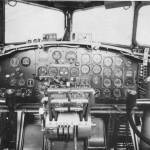 Sadly I can’t decipher the number he recorded in his logbook. It seems to read 3AAZU and makes no sense at the moment. Although my dad actually had a camera pictures were definitely a no-no but he was allowed to take notes and we reckon the B17 pictured was there at or around the time of his visit. Bovingdon was then a Combat Crew Replacement Unit and pretty important as it went. Eisenhower kept his personal B17 there and many an important chap passed through during the course of the war including Glenn Miller, Bob Hope and James Stewart. If there is such a thing as genetic memory then that may help explain my feelings for the B-17 but its more likely down to the enduring stories of the heroism of its young crews and the sheer strength of the aircraft. So, moving on….
Sadly I can’t decipher the number he recorded in his logbook. It seems to read 3AAZU and makes no sense at the moment. Although my dad actually had a camera pictures were definitely a no-no but he was allowed to take notes and we reckon the B17 pictured was there at or around the time of his visit. Bovingdon was then a Combat Crew Replacement Unit and pretty important as it went. Eisenhower kept his personal B17 there and many an important chap passed through during the course of the war including Glenn Miller, Bob Hope and James Stewart. If there is such a thing as genetic memory then that may help explain my feelings for the B-17 but its more likely down to the enduring stories of the heroism of its young crews and the sheer strength of the aircraft. So, moving on….
 Every so often neighbour Trev pops in with a bottle or two of Firsty Ferrit and a bundle of pictures acquired from hither and zither on account he is writing a book and intends giving talks on the lost Bomber Stations of East Anglia. This stretches to ‘interesting aircraft’ and a passion for Hunters and Lightnings of the English Electric type. So it was he turned up with a colour photo of Snafu, a B17F (no lower front turret just in case you were wondering, or not) over England. ‘Snafu’ is predominantly American WW2 terminology for ‘Situation Normal, all fouled up’ unless of course you go for the proper version as used in the film ‘Memphis Belle’ which uses stronger terminology. That the piccie is colour is something of a rarity but having had a few we got onto discussing how convenient it was that the Americans tended to name their aircraft meaning that, logically, it would therefore be pretty straightforward to find out a bit more about its history. We scanned and zoomed in and there they were, the pilots concentrating on flying her and a waistgunner clearly visible inside the aircraft. It was suddenly personal, we were looking at the crew so we set to searching the wibblywobbly in an effort to support our assumption. Eventually it became clear that the task was not as easy as it appeared so we moved onto the history of a nose cone from a Lightning that’s turned up at a mate of ours and the fact that the logbook the DVLA have sent for his DOT Vivi moped states it’s a Mobylette! We were now on mission though, leastways I was, and the next rainy evening the hunt for ‘Snafu’ and its crew re-commenced.
Every so often neighbour Trev pops in with a bottle or two of Firsty Ferrit and a bundle of pictures acquired from hither and zither on account he is writing a book and intends giving talks on the lost Bomber Stations of East Anglia. This stretches to ‘interesting aircraft’ and a passion for Hunters and Lightnings of the English Electric type. So it was he turned up with a colour photo of Snafu, a B17F (no lower front turret just in case you were wondering, or not) over England. ‘Snafu’ is predominantly American WW2 terminology for ‘Situation Normal, all fouled up’ unless of course you go for the proper version as used in the film ‘Memphis Belle’ which uses stronger terminology. That the piccie is colour is something of a rarity but having had a few we got onto discussing how convenient it was that the Americans tended to name their aircraft meaning that, logically, it would therefore be pretty straightforward to find out a bit more about its history. We scanned and zoomed in and there they were, the pilots concentrating on flying her and a waistgunner clearly visible inside the aircraft. It was suddenly personal, we were looking at the crew so we set to searching the wibblywobbly in an effort to support our assumption. Eventually it became clear that the task was not as easy as it appeared so we moved onto the history of a nose cone from a Lightning that’s turned up at a mate of ours and the fact that the logbook the DVLA have sent for his DOT Vivi moped states it’s a Mobylette! We were now on mission though, leastways I was, and the next rainy evening the hunt for ‘Snafu’ and its crew re-commenced.
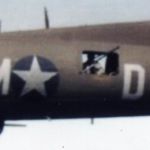 We did eventually find a copy of the picture he’d found in the National Air and Space Museum Archives and ‘Snafu’, serial number 42-3259, had been photographed by Rudy Arnold (1902-1966) the picture being described as ‘in flight shot left side aerial view of U.S. Army Air Forces Boeing B-17F Flying Fortress “Snafu” (s/n 42-3259) in flight’. Then things went a bit odd. We discovered another ‘Snafu’ but it suddenly became obvious that this new picture that we thought was the crew of 23259 wasn’t. This was a B-17G (front lower turret) Flying Fortress called ‘Snafu”. Now I don’t often go trawling about on the webbly as I tend to get sidetracked onto something else and suddenly find myself sideways through time checking out the lost cellars of York or some such and get completely confused by information overload which is exactly what happened when we discovered yet another one. The search wasn’t made any easier as Duxford has two B-17s and a Thunderbolt named ‘Snafu’! Well it was clearly time to standback, take stock and write it all down and hope we could make some sense of it all. It was also time to contact a few experts on the subject. Now if there is one thing World War historians are very good at it is Associations that have countless links. They have them for everything and they are the most helpful people you will come across. By now we had found a picture of what we thought was the crew of 42-3259. This was sort of confirmed when we found an illustration in a book about the B-17 Flying Fortress in Trev’s shed called ‘Units of the Eight Air Force’ by Martin Bowman but the picture didn’t quite ring true.
We did eventually find a copy of the picture he’d found in the National Air and Space Museum Archives and ‘Snafu’, serial number 42-3259, had been photographed by Rudy Arnold (1902-1966) the picture being described as ‘in flight shot left side aerial view of U.S. Army Air Forces Boeing B-17F Flying Fortress “Snafu” (s/n 42-3259) in flight’. Then things went a bit odd. We discovered another ‘Snafu’ but it suddenly became obvious that this new picture that we thought was the crew of 23259 wasn’t. This was a B-17G (front lower turret) Flying Fortress called ‘Snafu”. Now I don’t often go trawling about on the webbly as I tend to get sidetracked onto something else and suddenly find myself sideways through time checking out the lost cellars of York or some such and get completely confused by information overload which is exactly what happened when we discovered yet another one. The search wasn’t made any easier as Duxford has two B-17s and a Thunderbolt named ‘Snafu’! Well it was clearly time to standback, take stock and write it all down and hope we could make some sense of it all. It was also time to contact a few experts on the subject. Now if there is one thing World War historians are very good at it is Associations that have countless links. They have them for everything and they are the most helpful people you will come across. By now we had found a picture of what we thought was the crew of 42-3259. This was sort of confirmed when we found an illustration in a book about the B-17 Flying Fortress in Trev’s shed called ‘Units of the Eight Air Force’ by Martin Bowman but the picture didn’t quite ring true.  The crew had been identified as possibly the Meland crew but the records didn’t list him as having flown 259. Back row left to right is supposedly Meland (Pilot), Endelicato (Co-Pilot), Lt Walter K. Marttila (Navigator) and Mechling (Bombadier). Of the front row only Builta (second from the left) is known. Now I’m not convinced this is the same aircraft as the style of lettering is different and the cowls are clearly painted a different colour. It seems there is also some painted out artwork below the cockpit but this may be repairs. I am thinking this is yet another one. What we were sure about was that at the time of the air-to-air photograph 259 operated from RAF Grafton-Underwood and it was, to be specific, a B-17F-40-DL 42-3259, operated by the 94th Bomber Group 332nd Bomber Squadron but that seemed to be about it. Every road drew a blank but then we found a reference to its name having been changed to Alabama Whirlwind when it transferred to the 384th BG, 546th BS. It was time to ask for help in the form of Ray Bowden of the USAAF Nose Art Research Project who was trying to find some piccies of Snafu as Alabama Whirlwind! He very kindly informed us that 42-3259 was delivered to the USAAC on 13 April 1943 at Denver and was originally assigned to 94th BG. It was given the name Snafu at Smoky Hill Army Airforce Base, Salina, before deployment to the European Theatre of Operations. According to waist gunner Warren Weddow it was given that name by its pilot 1st Lt Victor Miller and flown to England with that title. It was first recorded at the 94th BG base on 10th May 1943 but it is believed to have departed the US in February. On 19th May 1943, flown by Lt Tower’s crew the plane was damaged by flak while attacking Flensburg. On 16th July 1943, Snafu was transferred to 384th BG’s 546th Sqn where it was re-named Alabama Whirlwind. On 24th July1943 it was again hit by flak over Heroya. It was still flying missions with 384BG when it was hit by flak yet again over Leipzig on 20 Feb 1944. Although he did not have a complete mission listing for the plane, it was flown on
The crew had been identified as possibly the Meland crew but the records didn’t list him as having flown 259. Back row left to right is supposedly Meland (Pilot), Endelicato (Co-Pilot), Lt Walter K. Marttila (Navigator) and Mechling (Bombadier). Of the front row only Builta (second from the left) is known. Now I’m not convinced this is the same aircraft as the style of lettering is different and the cowls are clearly painted a different colour. It seems there is also some painted out artwork below the cockpit but this may be repairs. I am thinking this is yet another one. What we were sure about was that at the time of the air-to-air photograph 259 operated from RAF Grafton-Underwood and it was, to be specific, a B-17F-40-DL 42-3259, operated by the 94th Bomber Group 332nd Bomber Squadron but that seemed to be about it. Every road drew a blank but then we found a reference to its name having been changed to Alabama Whirlwind when it transferred to the 384th BG, 546th BS. It was time to ask for help in the form of Ray Bowden of the USAAF Nose Art Research Project who was trying to find some piccies of Snafu as Alabama Whirlwind! He very kindly informed us that 42-3259 was delivered to the USAAC on 13 April 1943 at Denver and was originally assigned to 94th BG. It was given the name Snafu at Smoky Hill Army Airforce Base, Salina, before deployment to the European Theatre of Operations. According to waist gunner Warren Weddow it was given that name by its pilot 1st Lt Victor Miller and flown to England with that title. It was first recorded at the 94th BG base on 10th May 1943 but it is believed to have departed the US in February. On 19th May 1943, flown by Lt Tower’s crew the plane was damaged by flak while attacking Flensburg. On 16th July 1943, Snafu was transferred to 384th BG’s 546th Sqn where it was re-named Alabama Whirlwind. On 24th July1943 it was again hit by flak over Heroya. It was still flying missions with 384BG when it was hit by flak yet again over Leipzig on 20 Feb 1944. Although he did not have a complete mission listing for the plane, it was flown on  several occasions by the crews of Lt W A Jones and Lt J L Bedsole. On the last day of 1943 it was sent to the Strategic Air Depot at Little Staughton and returned to the Tinker Army Airforce Base in the USA on 5 August 1944. It was scrapped on 3 Jan 1946. Although, 42-3259 is well recorded as being named both as Snafu and Alabama Whirlwind there appear to be no photos showing this later title. So there you have it, that is about as much as we know about this particular ‘Snafu’ but already we’d found two more and possibly ‘discovered’ another.
several occasions by the crews of Lt W A Jones and Lt J L Bedsole. On the last day of 1943 it was sent to the Strategic Air Depot at Little Staughton and returned to the Tinker Army Airforce Base in the USA on 5 August 1944. It was scrapped on 3 Jan 1946. Although, 42-3259 is well recorded as being named both as Snafu and Alabama Whirlwind there appear to be no photos showing this later title. So there you have it, that is about as much as we know about this particular ‘Snafu’ but already we’d found two more and possibly ‘discovered’ another.
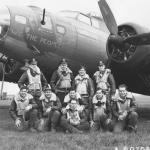 Seems though that we’d also stumbled upon a very popular aircraft and one that carried out about 76 missions without loss to any of the crews that flew her and was also credited with 13 enemy aircraft destroyed. This was a B-17F-27-BO serial number 41-24614 and was also based at Grafton Underwood for a short time. It appears that it arrived with the name ‘Snafu’ but was continually having technical problems. Fed up with this the crew re-named her ‘We the People’ and didn’t look back. Originally assigned to the 364BS, 305BG she arrived in Bangor on 10th September 1942 moving to Grafton Underwood on 25th October 1942 then later to RAF Chelveston. As ‘We The People’ she spent time with the 364th and 422nd Bomb Squadrons of the 305th. The most astonishing thing about the aircraft was that during its first 32 raids it carried 114 different crew members. It was, at the time, the most well known B-17 and the most popular with the crews that operated it. The picture is it as ‘We the People’ with Lt August E Weil and crew, reportedly taken in November 1942 at Grafton Underwood.
Seems though that we’d also stumbled upon a very popular aircraft and one that carried out about 76 missions without loss to any of the crews that flew her and was also credited with 13 enemy aircraft destroyed. This was a B-17F-27-BO serial number 41-24614 and was also based at Grafton Underwood for a short time. It appears that it arrived with the name ‘Snafu’ but was continually having technical problems. Fed up with this the crew re-named her ‘We the People’ and didn’t look back. Originally assigned to the 364BS, 305BG she arrived in Bangor on 10th September 1942 moving to Grafton Underwood on 25th October 1942 then later to RAF Chelveston. As ‘We The People’ she spent time with the 364th and 422nd Bomb Squadrons of the 305th. The most astonishing thing about the aircraft was that during its first 32 raids it carried 114 different crew members. It was, at the time, the most well known B-17 and the most popular with the crews that operated it. The picture is it as ‘We the People’ with Lt August E Weil and crew, reportedly taken in November 1942 at Grafton Underwood. 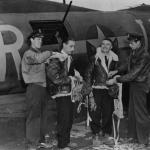 Interestingly enough we did come across some pictures of the crew kitting up a couple of reporters for a flight so it is just possible that the photo of the ‘Snafu’ that Trev found was taken from ‘We the People’ whilst serving with the 364th BS/305th BG. That would be neat. The ship, as the Americans liked to call them, became very well known and took part in some of the very few night raids on Germany alongside the RAF’s Wellingtons, Halifaxes and Stirlings but its smaller bomb load and the need for shielding on the large and complicated exhaust and machine guns to reduce glow meant that the idea was soon abandoned and the USAAF went back to daylight bombing.
Interestingly enough we did come across some pictures of the crew kitting up a couple of reporters for a flight so it is just possible that the photo of the ‘Snafu’ that Trev found was taken from ‘We the People’ whilst serving with the 364th BS/305th BG. That would be neat. The ship, as the Americans liked to call them, became very well known and took part in some of the very few night raids on Germany alongside the RAF’s Wellingtons, Halifaxes and Stirlings but its smaller bomb load and the need for shielding on the large and complicated exhaust and machine guns to reduce glow meant that the idea was soon abandoned and the USAAF went back to daylight bombing. 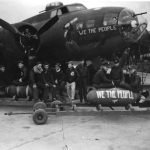 There is an account of one raid where ‘We the People’ is actually named. ‘On the night of September 8, 1943, the USAAF joined RAF Bomber Command on a night mission for the first time. Five B-17s from the 422nd Bomb Squadron, 305th Bomb Group, flew from Chelveston on a night mission to Boulogne in occupied France together with 257 aircraft from RAF Bomber Command comprising 119 Wellingtons, 112 Stirlings, 16 Mosquitoes and ten Halifaxes. The B-17s were led by Major Price in a bomber named “We The People”, and the target was the site of a German long-range gun battery. This target was supposed to be marked by Mosquitoes equipped with Oboe, a British blind targeting system based on radio transponder technology. However, the marking was not successful. The American crews found it difficult to differentiate the Target Indicators and there was also some confusion regarding radio signals while the bomb sights were deemed to be unsuitable. The German gun battery was probably not damaged, but on the other hand, no Allied aircraft were lost’. Eventually her unblemished record came to a sudden end at the hands of Herbert M. Connelley on 8th January 1944 when she was involved in a landing accident at Chelveston. The accident report states that ‘sufficient damage was caused to cause the aircraft to be written off’. Now that’s as maybe but it appears that she transferred to 1 Base
There is an account of one raid where ‘We the People’ is actually named. ‘On the night of September 8, 1943, the USAAF joined RAF Bomber Command on a night mission for the first time. Five B-17s from the 422nd Bomb Squadron, 305th Bomb Group, flew from Chelveston on a night mission to Boulogne in occupied France together with 257 aircraft from RAF Bomber Command comprising 119 Wellingtons, 112 Stirlings, 16 Mosquitoes and ten Halifaxes. The B-17s were led by Major Price in a bomber named “We The People”, and the target was the site of a German long-range gun battery. This target was supposed to be marked by Mosquitoes equipped with Oboe, a British blind targeting system based on radio transponder technology. However, the marking was not successful. The American crews found it difficult to differentiate the Target Indicators and there was also some confusion regarding radio signals while the bomb sights were deemed to be unsuitable. The German gun battery was probably not damaged, but on the other hand, no Allied aircraft were lost’. Eventually her unblemished record came to a sudden end at the hands of Herbert M. Connelley on 8th January 1944 when she was involved in a landing accident at Chelveston. The accident report states that ‘sufficient damage was caused to cause the aircraft to be written off’. Now that’s as maybe but it appears that she transferred to 1 Base 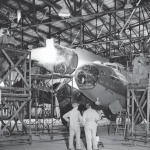 Air Depot at Burtonwood on 4th May 1944 and flew back to La Junta in the USA on 14th June 1944. So maybe she wasn’t quite that badly damaged then! Once Stateside she joined the First Motion Picture Unit and is pictured being a luvvie on August 10th 1944, probably making a training film. Following this she became a training aircraft and was renamed ‘Betty Central 0149’. Eventually she ended up being sold for scrap to the Reconstruction Finance Corporation on 31st July 1945 and was broken up at Searcey Field, the fate of the majority of the war-weary Flying Fortress survivors.
Air Depot at Burtonwood on 4th May 1944 and flew back to La Junta in the USA on 14th June 1944. So maybe she wasn’t quite that badly damaged then! Once Stateside she joined the First Motion Picture Unit and is pictured being a luvvie on August 10th 1944, probably making a training film. Following this she became a training aircraft and was renamed ‘Betty Central 0149’. Eventually she ended up being sold for scrap to the Reconstruction Finance Corporation on 31st July 1945 and was broken up at Searcey Field, the fate of the majority of the war-weary Flying Fortress survivors.
 The second picture we found which caused all the confusion had a much sadder and far more typical B-17 story. This shows the crew of 388th BG B-17G-15-BO ‘Snafu’ serial number 42-31393 and if you look closely it already has 5 kills painted up and a strip of bombing raids above so was taken towards the end of her career. Quite who they are we are not yet sure. It arrived in the UK from Cheyenne 28th October 1943 and was assigned to 560BS/388BG at RAF Knettishall on 14th December 1943. Its crew was initially led by Lt Sullivan, who we presume christened it and we know referred to it using the ruder version. She flew her first mission on 29th January 1944. The aircraft’s original bombardier, Lt Betastas, was killed by a 20mm cannon shell from an enemy fighter on the Berlin Mission of 8th March 1944. On 29th April 1944, renamed ‘Snaky’ and with Lt Walker’s crew aboard she carried out her 26th and last mission to Berlin, an eight hour round trip. Having been hit by flak which caused a fire in the bomb bay, they were finally brought down by fighters 17 miles north of Helmstedt at Giebel Lodge near Parsau, Germany. Missing Air Crew Report 4243 SNAFU aka SNAKY confirms this. Whether they baled out or survived the crash itself we don’t know but we did come across a letter from Bill Homrighausen, a relative of the Navigator Bill Underwood, who was seeking information on the aircraft and said that his father-in-law had been taken prisoner and spent the rest of the war in Stalag Luft III, scene of real Great Escape. There was a bit of a contradiction on the site of the crash but it seems most likely that it did occur in Germany near Parsau as this would have been on their route home. There is a description of this Mission, number 102, in Ed Huntzinger’s excellent book ‘The 388th At War’. ‘On this mission, the 388th furnished 21 aircraft for the low Group of the 45th Combat Wing, and 7 aircraft for the high squadron of the 452nd Bomb Group. The 452nd was the high Group in the Wing formation. 3 spare aircraft also took-off for fill-ins. 31 aircraft were airborne by 0653 hours and assembled in respective formations without difficulty. The Target for the entire 8th Air Force was Berlin. The briefed course was followed to the Target and six aircraft aborted for mechanical reasons. Bombing was done visually with bombs away at 1125 hours from 25,500 feet. The Primary MPI was not hit, but all of the bombs fell in the Southeast area on Tempelhof Airdrome. Some bombs fell on Potsdamer and Anhalter Railroad Stations. Two direct hits were on bridges crossing the Canal north of Potsdamer Station. The flak at the Target and Magdeburg was very accurate resulting in the death of Lt. Miller, pilot, and S/Sgt. Boring, radioman. 8 crew members were wounded and all aircraft had battle damage. No enemy aircraft were encountered. 23 aircraft returned to base by 1538 hours and two are missing. Lt. Walker in a/c 42-31393, was hit by flak over the target and they had to leave the formation. He was then attacked by enemy fighters and shot down. The plane crashed near Parsay(u). Lt. Walker was wounded and was found dead in a field at 0800 hours on May 24th, nearly a month after being shot down. Lt. Coyner in a/c 42-37980, was hit by fighters and crash-landed on fire 20 miles West of Ypern, Holland’. There is an
The second picture we found which caused all the confusion had a much sadder and far more typical B-17 story. This shows the crew of 388th BG B-17G-15-BO ‘Snafu’ serial number 42-31393 and if you look closely it already has 5 kills painted up and a strip of bombing raids above so was taken towards the end of her career. Quite who they are we are not yet sure. It arrived in the UK from Cheyenne 28th October 1943 and was assigned to 560BS/388BG at RAF Knettishall on 14th December 1943. Its crew was initially led by Lt Sullivan, who we presume christened it and we know referred to it using the ruder version. She flew her first mission on 29th January 1944. The aircraft’s original bombardier, Lt Betastas, was killed by a 20mm cannon shell from an enemy fighter on the Berlin Mission of 8th March 1944. On 29th April 1944, renamed ‘Snaky’ and with Lt Walker’s crew aboard she carried out her 26th and last mission to Berlin, an eight hour round trip. Having been hit by flak which caused a fire in the bomb bay, they were finally brought down by fighters 17 miles north of Helmstedt at Giebel Lodge near Parsau, Germany. Missing Air Crew Report 4243 SNAFU aka SNAKY confirms this. Whether they baled out or survived the crash itself we don’t know but we did come across a letter from Bill Homrighausen, a relative of the Navigator Bill Underwood, who was seeking information on the aircraft and said that his father-in-law had been taken prisoner and spent the rest of the war in Stalag Luft III, scene of real Great Escape. There was a bit of a contradiction on the site of the crash but it seems most likely that it did occur in Germany near Parsau as this would have been on their route home. There is a description of this Mission, number 102, in Ed Huntzinger’s excellent book ‘The 388th At War’. ‘On this mission, the 388th furnished 21 aircraft for the low Group of the 45th Combat Wing, and 7 aircraft for the high squadron of the 452nd Bomb Group. The 452nd was the high Group in the Wing formation. 3 spare aircraft also took-off for fill-ins. 31 aircraft were airborne by 0653 hours and assembled in respective formations without difficulty. The Target for the entire 8th Air Force was Berlin. The briefed course was followed to the Target and six aircraft aborted for mechanical reasons. Bombing was done visually with bombs away at 1125 hours from 25,500 feet. The Primary MPI was not hit, but all of the bombs fell in the Southeast area on Tempelhof Airdrome. Some bombs fell on Potsdamer and Anhalter Railroad Stations. Two direct hits were on bridges crossing the Canal north of Potsdamer Station. The flak at the Target and Magdeburg was very accurate resulting in the death of Lt. Miller, pilot, and S/Sgt. Boring, radioman. 8 crew members were wounded and all aircraft had battle damage. No enemy aircraft were encountered. 23 aircraft returned to base by 1538 hours and two are missing. Lt. Walker in a/c 42-31393, was hit by flak over the target and they had to leave the formation. He was then attacked by enemy fighters and shot down. The plane crashed near Parsay(u). Lt. Walker was wounded and was found dead in a field at 0800 hours on May 24th, nearly a month after being shot down. Lt. Coyner in a/c 42-37980, was hit by fighters and crash-landed on fire 20 miles West of Ypern, Holland’. There is an 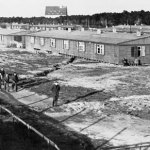 account that Lt Don Walker, originally from Springfield Massechusetts, was shot evading capture. The rest of the crew, Co-pilot Claud Patat, Navigator Bill Underwood, Bombardier Jack Terry, Flight engineer/top turret gunner Dick Danckwerth, Radio Operator Bob Strough, Ball turret gunner Bob Adams (wounded in Action), Waist gunner Sam Swim, Waist gunner Theo Bower, Tail gunner Mike Kozak survived and became Prisoners of War.
account that Lt Don Walker, originally from Springfield Massechusetts, was shot evading capture. The rest of the crew, Co-pilot Claud Patat, Navigator Bill Underwood, Bombardier Jack Terry, Flight engineer/top turret gunner Dick Danckwerth, Radio Operator Bob Strough, Ball turret gunner Bob Adams (wounded in Action), Waist gunner Sam Swim, Waist gunner Theo Bower, Tail gunner Mike Kozak survived and became Prisoners of War.
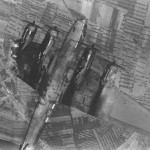 The stories we found about the aircraft and crews we’d identified were happier than most as sadly many were lost on their first missions. It is a fact that new B-17 and B-24 crews arriving towards the end of the war were equipped with older and seriously tired aircraft as they were not expected to survive more than a few missions and many ended up being re-named making identification extremely difficult. Its amazing that so many people have taken the trouble to put all the information together but, even so, investigating any old aircraft or their crews is difficult. For me the exercise has brought home the tragic fact that many aircraft or crews never saw the end of the war and have ended up as unidentified personnel in photographs standing proudly in front of aircraft that would never return them home. The personal thing concerning the B17 crews really started when we first went to Eccles Hall, next door to the old Snetterton Heath airfield. During the WW2 the School was the hospital site for Snetterton Heath and Old Buckenham airfields amongst others and still has, and uses, some of the original military buildings and in one is a fantastic little museum dedicated to the 96th BG. On other visits to do check-outs and the like we would occasionally bump into an American veteran and we were privileged to attend a re-union some years ago and saw the B17 in ‘Memphis Belle’ coIours swoop in low
The stories we found about the aircraft and crews we’d identified were happier than most as sadly many were lost on their first missions. It is a fact that new B-17 and B-24 crews arriving towards the end of the war were equipped with older and seriously tired aircraft as they were not expected to survive more than a few missions and many ended up being re-named making identification extremely difficult. Its amazing that so many people have taken the trouble to put all the information together but, even so, investigating any old aircraft or their crews is difficult. For me the exercise has brought home the tragic fact that many aircraft or crews never saw the end of the war and have ended up as unidentified personnel in photographs standing proudly in front of aircraft that would never return them home. The personal thing concerning the B17 crews really started when we first went to Eccles Hall, next door to the old Snetterton Heath airfield. During the WW2 the School was the hospital site for Snetterton Heath and Old Buckenham airfields amongst others and still has, and uses, some of the original military buildings and in one is a fantastic little museum dedicated to the 96th BG. On other visits to do check-outs and the like we would occasionally bump into an American veteran and we were privileged to attend a re-union some years ago and saw the B17 in ‘Memphis Belle’ coIours swoop in low 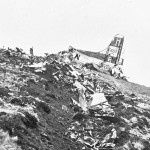 over the Hall. It was all very moving. I still always make a point of trying to land near, or on, an old airfield when flying in and around Norfolk in some sort of honour of these largely forgotten places. The figures are awesome. Of the one and half million tons of ordnance dropped on Germany during the war over 640,000 tons was dropped by B-17s. Around 12,000 Flying Fortresses were built and a nigh on a quarter of a million personnel served in them during the 300,000 missions they flew. By the end of the war 4,735 had been lost in combat and 46,500 crewmembers had either been killed or wounded and thousands more become prisoners of war. How wonderful then we found out that bit more about a few of them.
over the Hall. It was all very moving. I still always make a point of trying to land near, or on, an old airfield when flying in and around Norfolk in some sort of honour of these largely forgotten places. The figures are awesome. Of the one and half million tons of ordnance dropped on Germany during the war over 640,000 tons was dropped by B-17s. Around 12,000 Flying Fortresses were built and a nigh on a quarter of a million personnel served in them during the 300,000 missions they flew. By the end of the war 4,735 had been lost in combat and 46,500 crewmembers had either been killed or wounded and thousands more become prisoners of war. How wonderful then we found out that bit more about a few of them.
Big thankyous to all that helped in our endeavours, the story will, I’m sure, continue. If you click on any of the piccies they should enlarge.
http://www.usaaf-noseart.co.uk/ Ray Bowden’s site
http://www.americanairmuseum.com/aircraft/527
http://www.joebaugher.com/ All the numbers and info on the USAAF aircraft
http://www.388bg.info/ The 388th’s website
http://airandspace.si.edu/collections/search/?fq=set_name:%22Rudy%20Arnold%20Photo%20Collection%22 Rudy Arnold’s Collection
http://384thbombgroup.com/ The 384th’s website
http://www.warhistoryonline.com/whotube-2/b-17-low-passes-war-lover.html low flyby of a B17 at Bovingdon during the making of The War Lover starring Steve McQueen.
http://www.americanairmuseum.com/media/3601 Bovingdon images
https://books.google.co.uk/books?id=w4BqBQAAQBAJ&pg=PA33&lpg=PA33&dq=we+the+people+b-17&source=bl&ots=43zg9ppLtV&sig=jeDkoh_gA7YF4bpXuGVzMNYyut4&hl=en&sa=X&ei=kUGVVIa9MIbXaqb8gfgM&ved=0CDoQ6AEwBQ#v=onepage&q=we%20the%20people%20b-17&f=false Loads here about B-17s including ‘We the People’.
02/10/19 Un-named Crew of Snafu identified
One of the bonuses of writing up articles is the feedback we get. Just when its all gone quiet suddenly another touch from the past whizzes in. We were delighted to receive this from Rick Kacenski. We had not been able to identify the crew pictured alongside B17G-15-BO s/n 42-31393 and feared it was the one lost. It turns out the picture is of Sullivan’s crew who, all apart from Lt Betastas survived the war. The picture must have been taken after the 8th March 1944 as Lt Betastas is not listed. To hear from a direct relation and have their identities revealed was warmly welcomed. Thankyou.
 I had just happened across your 2014 article on the B-17’s named Snafu. At my desk I have the image of my Dad’s crew under the nose of SNAFU (complete with nose turret). He was with the 8th Air Force, 588th stationed at Knettishall with Lt. Sullivan most of his missions. His crew all made it through 28 missions except for the bombardier. They flew most of their missions on the SNAFU except when it was in the shop as I understand. Their last mission was on April 27, 1944 and my Dad told me that the new crew was shot down on their first mission on the SNAFU a few days later. The image I assume you had of the crew mentioned in your article was blank so I could not confirm it was the same one I have. Crew of the 560th Bomb Squadron, 388th Bomb Group, beside the Boeing B-17 Flying Fortress “Snafu”. England, 13 April 1944. Left to right: 2nd Lt. Leo W. Sullivan, Corning, Iowa; T/Sgt. John F. Belsey, New York, New York; 2nd Lt. John E. Turner, Wooster, Ohio; S/Sgt. Marion L. Kacenski, Maryville, Illinois; S/Sgt. Edwin H. Wright, Atlanta, Georgia; T/Sgt. Matthew S. Braniff, New Orleans, Louisiana; 2nd Lt. Ralph l. Campbell, Butler, Indiana; T/Sgt. Frank E. Waugh, Marshall, Texas; Sgt. Merrick J. Castille, Arnaudville, Louisiana. My Dad told me about a Stars & Stripes photographer taking a photo of their crew but he never saw it. I remembered that and on a whim a couple years back and I started to google SNAFU and such, and came across the 8th Air Force site. Knowing his bomber group and base I searched and eventually found the crew’s and plane’s info by their pilot, Lt. Sullivan. Through that I found the plane/crew photo (instantly recognized my Dad just left of center), the back of the photo was also on the site and listed the crew by name, and a photo of the ground crew on the plane.
I had just happened across your 2014 article on the B-17’s named Snafu. At my desk I have the image of my Dad’s crew under the nose of SNAFU (complete with nose turret). He was with the 8th Air Force, 588th stationed at Knettishall with Lt. Sullivan most of his missions. His crew all made it through 28 missions except for the bombardier. They flew most of their missions on the SNAFU except when it was in the shop as I understand. Their last mission was on April 27, 1944 and my Dad told me that the new crew was shot down on their first mission on the SNAFU a few days later. The image I assume you had of the crew mentioned in your article was blank so I could not confirm it was the same one I have. Crew of the 560th Bomb Squadron, 388th Bomb Group, beside the Boeing B-17 Flying Fortress “Snafu”. England, 13 April 1944. Left to right: 2nd Lt. Leo W. Sullivan, Corning, Iowa; T/Sgt. John F. Belsey, New York, New York; 2nd Lt. John E. Turner, Wooster, Ohio; S/Sgt. Marion L. Kacenski, Maryville, Illinois; S/Sgt. Edwin H. Wright, Atlanta, Georgia; T/Sgt. Matthew S. Braniff, New Orleans, Louisiana; 2nd Lt. Ralph l. Campbell, Butler, Indiana; T/Sgt. Frank E. Waugh, Marshall, Texas; Sgt. Merrick J. Castille, Arnaudville, Louisiana. My Dad told me about a Stars & Stripes photographer taking a photo of their crew but he never saw it. I remembered that and on a whim a couple years back and I started to google SNAFU and such, and came across the 8th Air Force site. Knowing his bomber group and base I searched and eventually found the crew’s and plane’s info by their pilot, Lt. Sullivan. Through that I found the plane/crew photo (instantly recognized my Dad just left of center), the back of the photo was also on the site and listed the crew by name, and a photo of the ground crew on the plane.
Just wanted to share that with. Thanks for your article, I’ve enjoyed reading it and appreciate the research you’ve done. Cheers, Rick Kacenski, St. Louis, Missouri, USA